Last month I got invited to drive two new Mazda's in San Diego - the CX-5 and the MX-5 RF. After weeks of counting down the days till I could get behind the wheel, when I saw the itinerary I was crushed to see that I'd be sitting in design seminars for as much (maybe more?) time than we'd actually be behind the wheel. Nothing quite made sense. After all, this was a car launch event and driving matters ... right? After some initial disappointment though I decided to simply make the best of the situation and try to learn something. I'm glad I did! While there was the minutia of how many bushings were created and how sound were avoided by adding an extra micron of padding here and there, the ultimate takeaway was something greater. Mazda guys really live and breath a design philosophy that quite frankly has created some of the finest cars in the industry today.
This inspiration comes from the the Japanese phrase, "Jinba Ittai" meaning to look at the "horse and rider as one", instead of two separate entities. They have taken this philosophy to modern automotive design and are working to create the perfect driving experience. With less than 2% of the global automotive market, Mazda isn't looking to be the "next Toyota" and that liberates them to avoid making cars for everyone. Instead, they are focused on designing driving experiences that are as rewarding as possible. This in turn has resulted in an extremely loyal customer base that tends to be wealthier and higher educated compared to those purchasing competitive vehicles.
Throughout the next couple days, this philosophy came to life as we explored not just the phenomenal 2017 CX-5 and MX-5 RF but also other cars that they used as design studies. While the CX-5 and MX-5 RF are clearly two dramatically different vehicles, they both share the same design philosophy, one that I now am able to identify across their entire portfolio.
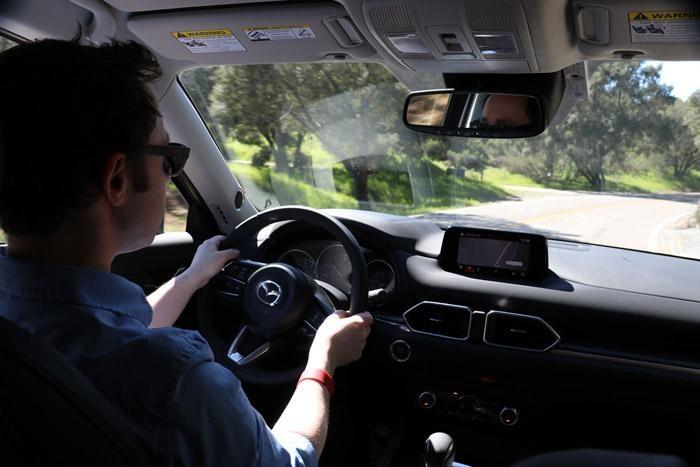 From the moment you touch the door handle to the press of the ignition button has been designed around the spirit of Jiba Ittai. This includes creating a distraction free cockpit where pertinent information is delivered through a HUD and navigation system, while improving visibility for the driver to stay connected with the road.
From the moment you touch the door handle to the press of the ignition button has been designed around the spirit of Jiba Ittai. This includes creating a distraction free cockpit where pertinent information is delivered through a HUD and navigation system, while improving visibility for the driver to stay connected with the road.
Jinba Ittai Starts Before You Turn the Key ...
All too often, reports on a new car focus on high-level features and stats about +2 mpg or -3 db NVH when any consumer recognizes that they create an immediate feeling about the vehicle from teh moment they touch the handle to open the door. Mazda's engineers adressed this as well, looking not just at materials, but angles as well. Among one of the greatest improvements in the CX-5 is that the rear doors open 80º vs 74º. While that might seem like a minuscule change, the impact is actually huge when you consider all those times a box, a safety seat, or a bulky school project "almost fit" in the back seat. Even when you were able to wedge it in somehow, wouldn't it have been nice to avoid that stress?
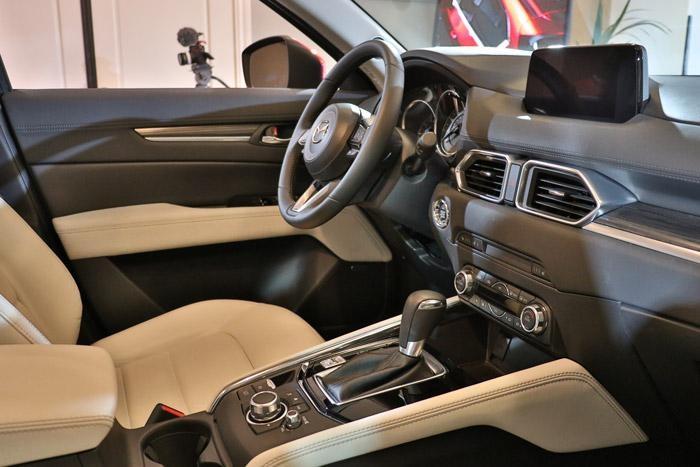 The CX-5 features an enhanced premium feel that was among the most comfortable I've experienced in the class. It draws luxury inspiration and features premium materials but doesn't distract from the driving experience.
The CX-5 features an enhanced premium feel that was among the most comfortable I've experienced in the class. It draws luxury inspiration and features premium materials but doesn't distract from the driving experience.
Little Details Make a Big Impact
Mazda is obsessed with making the CX-5 quiet (and they did a great job). They went through and addressed hundreds of spots throughout the vehicle to address noise, but as nice as that is, there are even more subtle improvements. By examining the position of your "pedal foot" as it shifts from gas to brake, they were able to determine an optimal placement that didn't require the driver to lift his foot. While this allows for less stress and a more enjoyable experience generally, in practice this could save lives. The reaction time was 0.12 seconds between two two experiences and at 60 mph, that is 10.5 feet of stopping distance saved!
Additionally, by tuning the accelerator curve to be linear it's easier for the driver to control compared to some other vehicles which might start out slow and then ramp up fast.
Finally, not all steering wheels are centered. However, during the presentation showed us several competitive examples of where the wheel is slightly offset and how having it perfectly aligned center to the driver was superior. After having a chance to drive a vehicle where it wasn't aligned properly, they are right and it goes to show that sometimes you just need to question everything and look at all the tiny details.
By itself, none of these points are going to make or break your decision to buy the car or not. However, when you consider it all together as part of their Jinba Ittai philosophy it becomes clear that Mazda is obsessed with creating the perfect cars for people who love to drive.
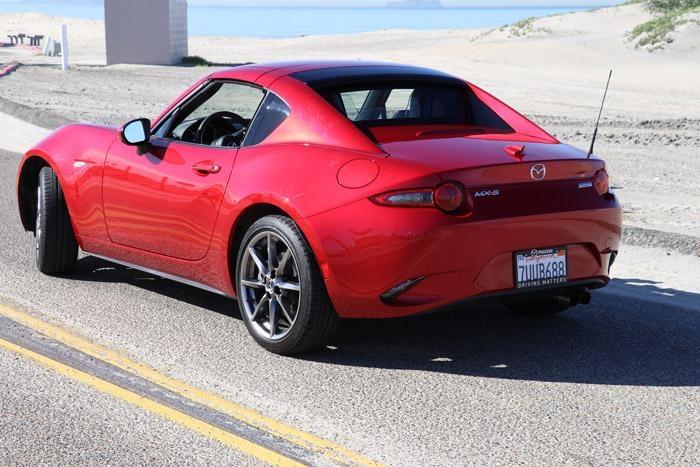 Even as a big guy driving a tiny fast back roadster, it was the thrill of driving an amazing machine that kept me going. It truly felt like man and machine were one.
Even as a big guy driving a tiny fast back roadster, it was the thrill of driving an amazing machine that kept me going. It truly felt like man and machine were one.
It's About Muscles Control The Car
At first, one might simply think of sliding the seat back or forward to adjust for better fit and control. That's simply better access to the controls though ... not better control over the driving experience! That's a subtle difference but it makes a big impact when you think about it.
However, the Mazda engineers looked at tons of other data points including the shape of the wheel itself, position of the headrest, position of the hinge on the pedal, and the length of the column on the steering wheel itself.
Not only did they look at the static positioning or comfort and fatigue impacts of the positioning, but also the jerk response to acceleration and deceleration to make the car as perfectly tuned to the driver's body as possible. From a practical perspective, when driving curvy roads in the CX-5 the G-Vectoring allows you to get a much smoother ride and spend more energy focused on driving and less bracing against the impact of the curve. This results in a safer, smoother, more enjoyable experience for both driver and passengers.
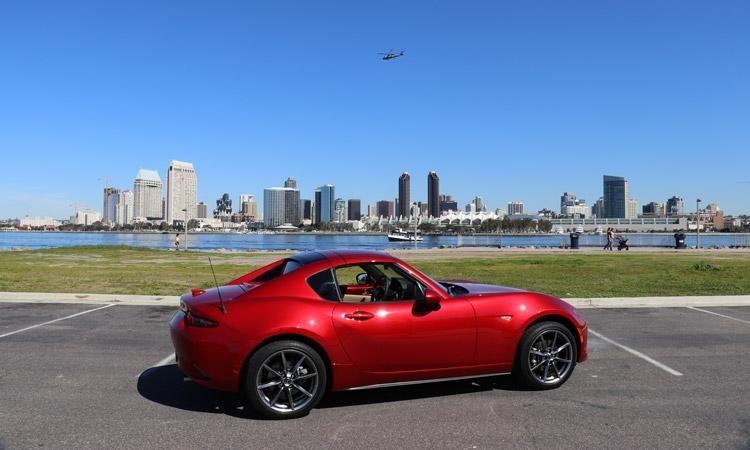 While the Mazda MX-5 RF may look like a million dollars, it's not all about money - it's about the experience of driving and connecting to the road. With the addition of the retractable hard top fastback, you get the benefits of a coup when the weather isn't as sunny as it is in San Diego!
While the Mazda MX-5 RF may look like a million dollars, it's not all about money - it's about the experience of driving and connecting to the road. With the addition of the retractable hard top fastback, you get the benefits of a coup when the weather isn't as sunny as it is in San Diego!
Cost is Not Always Better
This final area was a bit confusing since it goes against virtually everything our society tells us today.
However, it should be obvious that cost is not always better. We looked at four vehicles - Audi Q3, BMW X1, Lexus NX200t, and Mercedes GLA. Without going into specifics here, it's clear that there are aspects to these other cars that I enjoyed better than the CX-5 costing 10's of thousands less. However, the core essence of driving was not always superior in these "luxury" vehicles.
While the engines might be bigger, seats might be more cushiony, and the chrome my be shinier, it was clear that for the aspects that made the ride better for a driver who wants do experience the joy of driving, that Mazda had them beat.
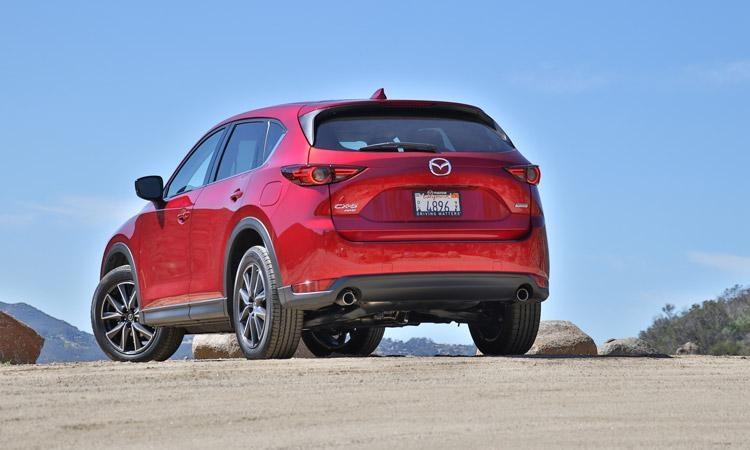 The Mazda CX-5 is one of the best CUVs on the market today and it's as fun to drive as it was to take photos of!
The Mazda CX-5 is one of the best CUVs on the market today and it's as fun to drive as it was to take photos of!
Final Thoughts ...
I've been fortunate to work with a bunch of different design teams and for better or worse, I'm also very transparent when it comes to my thoughts on corporate bullshittery.
I don't think for a moment that designers at other manufacturers set out to make a lopsided steering wheel because they were lazy or a non linear curve because they couldn't draw a nice curved line. There's always some design choices to be made and sacrifices to be accounted for.
To that end, while the Mazda CX-5 is one of the finest CUVs on the market today - it isn't perfect for everyone and sometimes, some people prefer a slower acceleration curve for urban driving that ramps up to accelerate quickly around corners or onto expressways. What matters though is that there's a reason behind choices and that you should absolutely test drive the new CX-5 (and while you are there, convince your wife to let you take a spin in the MX-5 too!). Not everyone is a "Mazda Driver", but those who are, know that when you choose a Mazda you are getting a total package designed around some one who knows that Driving Matters.
Stay tuned in a couple weeks for our roundup of four awesome new CUVs that are available now so that you can pick which one works best for your lifestyle.
